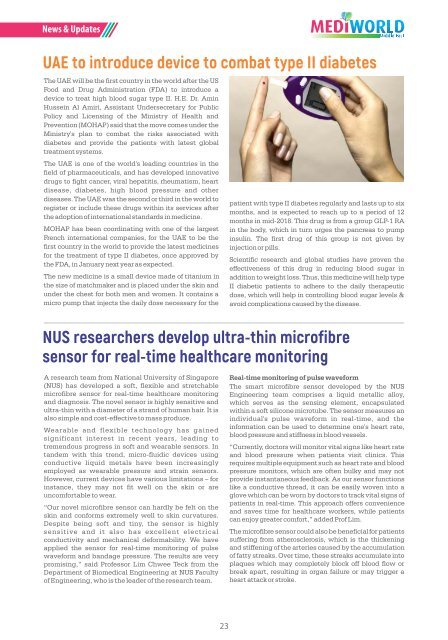Mediworld Final Draft for Print
Create successful ePaper yourself
Turn your PDF publications into a flip-book with our unique Google optimized e-Paper software.
News & Updates<br />
UAE to introduce device to combat type II diabetes<br />
The UAE will be the first country in the world after the US<br />
Food and Drug Administration (FDA) to introduce a<br />
device to treat high blood sugar type II. H.E. Dr. Amin<br />
Hussein Al Amiri, Assistant Undersecretary <strong>for</strong> Public<br />
Policy and Licensing of the Ministry of Health and<br />
Prevention (MOHAP) said that the move comes under the<br />
Ministry's plan to combat the risks associated with<br />
diabetes and provide the patients with latest global<br />
treatment systems.<br />
The UAE is one of the world's leading countries in the<br />
field of pharmaceuticals, and has developed innovative<br />
drugs to fight cancer, viral hepatitis, rheumatism, heart<br />
disease, diabetes, high blood pressure and other<br />
diseases. The UAE was the second or third in the world to<br />
register or include these drugs within its services after<br />
the adoption of international standards in medicine.<br />
MOHAP has been coordinating with one of the largest<br />
French international companies, <strong>for</strong> the UAE to be the<br />
first country in the world to provide the latest medicines<br />
<strong>for</strong> the treatment of type II diabetes, once approved by<br />
the FDA, in January next year as expected.<br />
The new medicine is a small device made of titanium in<br />
the size of matchmaker and is placed under the skin and<br />
under the chest <strong>for</strong> both men and women. It contains a<br />
micro pump that injects the daily dose necessary <strong>for</strong> the<br />
patient with type II diabetes regularly and lasts up to six<br />
months, and is expected to reach up to a period of 12<br />
months in mid-2018. This drug is from a group GLP-1 RA<br />
in the body, which in turn urges the pancreas to pump<br />
insulin. The first drug of this group is not given by<br />
injection or pills.<br />
Scientific research and global studies have proven the<br />
effectiveness of this drug in reducing blood sugar in<br />
addition to weight loss. Thus, this medicine will help type<br />
II diabetic patients to adhere to the daily therapeutic<br />
dose, which will help in controlling blood sugar levels &<br />
avoid complications caused by the disease.<br />
NUS researchers develop ultra-thin microfibre<br />
sensor <strong>for</strong> real-time healthcare monitoring<br />
A research team from National University of Singapore<br />
(NUS) has developed a soft, flexible and stretchable<br />
microfibre sensor <strong>for</strong> real-time healthcare monitoring<br />
and diagnosis. The novel sensor is highly sensitive and<br />
ultra-thin with a diameter of a strand of human hair. It is<br />
also simple and cost-effective to mass produce.<br />
Wearable and flexible technology has gained<br />
significant interest in recent years, leading to<br />
tremendous progress in soft and wearable sensors. In<br />
tandem with this trend, micro-fluidic devices using<br />
conductive liquid metals have been increasingly<br />
employed as wearable pressure and strain sensors.<br />
However, current devices have various limitations – <strong>for</strong><br />
instance, they may not fit well on the skin or are<br />
uncom<strong>for</strong>table to wear.<br />
“Our novel microfibre sensor can hardly be felt on the<br />
skin and con<strong>for</strong>ms extremely well to skin curvatures.<br />
Despite being soft and tiny, the sensor is highly<br />
sensitive and it also has excellent electrical<br />
conductivity and mechanical de<strong>for</strong>mability. We have<br />
applied the sensor <strong>for</strong> real-time monitoring of pulse<br />
wave<strong>for</strong>m and bandage pressure. The results are very<br />
promising,” said Professor Lim Chwee Teck from the<br />
Department of Biomedical Engineering at NUS Faculty<br />
of Engineering, who is the leader of the research team.<br />
Real-time monitoring of pulse wave<strong>for</strong>m<br />
The smart microfibre sensor developed by the NUS<br />
Engineering team comprises a liquid metallic alloy,<br />
which serves as the sensing element, encapsulated<br />
within a soft silicone microtube. The sensor measures an<br />
individual's pulse wave<strong>for</strong>m in real-time, and the<br />
in<strong>for</strong>mation can be used to determine one's heart rate,<br />
blood pressure and stiffness in blood vessels.<br />
“Currently, doctors will monitor vital signs like heart rate<br />
and blood pressure when patients visit clinics. This<br />
requires multiple equipment such as heart rate and blood<br />
pressure monitors, which are often bulky and may not<br />
provide instantaneous feedback. As our sensor functions<br />
like a conductive thread, it can be easily woven into a<br />
glove which can be worn by doctors to track vital signs of<br />
patients in real-time. This approach offers convenience<br />
and saves time <strong>for</strong> healthcare workers, while patients<br />
can enjoy greater com<strong>for</strong>t,” added Prof Lim.<br />
The microfibre sensor could also be beneficial <strong>for</strong> patients<br />
suffering from atherosclerosis, which is the thickening<br />
and stiffening of the arteries caused by the accumulation<br />
of fatty streaks. Over time, these streaks accumulate into<br />
plaques which may completely block off blood flow or<br />
break apart, resulting in organ failure or may trigger a<br />
heart attack or stroke.<br />
23

















